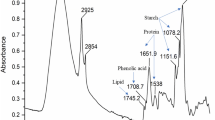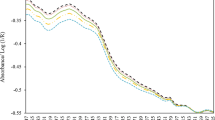Abstract
This study aimed to monitor nutritional and chemical changes of oats grain by wet chemistry and Fourier transformed infrared spectroscopy (FTIR). Oats grain fermented with or without inoculants of Aspergillus oryzae (AO), AO + Bacillus subtilis (C + D), Saccharomyces cerevisiae (SC), and Lactobacillus salivarius (LBS) was first analysed by wet chemistry for chemical and nutritional compositions. Then, analysed values were predicted by FTIR spectroscopy based on partial least square regression (PLSR). Crude protein increased with LBS and AO fermentations. AO and SC fermentation reduced dietary fibre, tannin and phytic acid contents. Highest fibre degradation was obtained from LBS fermentation, and highest organic acid production from AO and C + D fermentations. In the determination of chemical and nutrient contents, the method performance characteristics of FTIR-PLSR was better than that of wet chemistry methods, with precision values of 0.15–9.5% and accuracy values of around 100% (R2 of 0.954–0.998 and standard error of prediction of 0.024–0.001). Furthermore, FTIR spectra deconvolution showed that oats starch had an overall 5–13% increased amorphous structure and 6–17% reduced proportion of crystalline structure due to the effect of fermentations. Fermentation lead to increased α-helix and side chain of peptides + amino acids, but decreased β-sheet and β-turn. Fermentation caused nutritionally and chemically valuable oats grain and FTIR-PLSR method produced a fast, non-destructive and robust determination.



Similar content being viewed by others
References
A. Kristek, M.Y. Schar, G. Soycan, S. Alsharif, G.G.C. Kuhnle, G. Walton, J.P.E. Spencer, Nutr. Bull. 43, 358–373 (2018). https://doi.org/10.1111/nbu.12354
M.E. Camire, Overview of grain components and changes occurring in Grain Constituents with Different Forms of Processing, in Cereal Grain-based Functional Foods: Carbohydrate and Phytochemical Components. ed. by T. Beta, M.E. Camire (Thomas Graham House, Cambridge, 2019), p.12
S. Salazar-Villanea, W.H. Hendriks, E.M. Bruininx, H. Gruppen, A.F. van der Poel, Nutr. Res. Rev. 29, 126–141 (2016). https://doi.org/10.1017/S0954422416000056
S. Yasar, M.S. Gok, Bull. Univ. Agric. Sci. Vet. Med. Cluj-Napoca Anim. Sci. Biotechnol. 71, 51–62 (2014)
S. Yasar, M.S. Gok, Y. Gurbuz, Turk. J. Vet. Anim. Sci. 40, 313–322 (2016). https://doi.org/10.3906/vet-1505-44
S. Yasar, I. Okutan, R. Tosun, J. Inst. Sci. Tech. 7, 297–308 (2017)
S.B. Cai, F.Y. Gao, X.D. Zhang, O. Wang, W. Wu, S.J. Zhu, D. Zhang, F. Zhou, B.P. Ji, J. Food. Sci. Technol. 51, 2544–2551 (2014). https://doi.org/10.1007/s13197-012-0748-2
S.B. Cai, O. Wang, W. Wu, S.J. Zhu, F. Zhou, B.P. Ji, F.Y. Gao, D. Zhang, J. Liu, Q. Cheng, J. Agric. Food Chem. 60, 507–513 (2012). https://doi.org/10.1021/jf204163a
Y. Xiao, X. Rui, G.L. Xing, H. Wu, W. Li, X.H. Chen, M. Jiang, M.S. Dong, J. Funct. Foods 16, 58–73 (2015). https://doi.org/10.1016/j.jff.2015.04.032
H. Zhang, J. Ma, Y. Miao, T. Tuchiya, J.Y. Chen, J. Oleo. Sci. 64, 375–380 (2015). https://doi.org/10.5650/jos.ess14201
M. Rahman, K. Theodoridou, P. Yu, J. Anim. Sci. Biotechnol. 7, 1–6 (2016). https://doi.org/10.1186/s40104-016-0111-y
S. Yasar, R. Tosun, Arch. Anim. Nutr. 72, 407–423 (2018). https://doi.org/10.1080/1745039X.2018.1500242
S. Yasar, M.H. Alma, R. Tosun, T. Salan, J. Anim. Feed Sci. 28, 282–290 (2019)
S. Yasar, R. Tosun, Z. Sonmez, Measurements 161, 107895 (2020). https://doi.org/10.1016/j.measurement.2020
TSE, Hayvan yem maddeleri–Lactobacillus spp. Izolasyonu ve sayımı (15787/2009) (Türk Standartları Enstitüsü, Ankara, 2009)
TSE, Hayvan yemleri -Maya probiyotik susların ayrımı ve sayımı (15788/2009) (Türk Standartları Enstitüsü, Ankara, 2009)
ISO, Microbiology of food and animal feeding stuffs - Horizontal method for the enumeration of yeasts and moulds - Part 1: Colony count technique in products with water activity greater than 0,95 (ISO 21527–1:2008) (International Organization for Standardization, Geneva, 2008)
ISO, Microbiology of food and animal feeding stuffs - Horizontal method for the enumeration of yeasts and moulds - Part 2: Colony count technique in products with water activity less than or equal to 0,95 (21527–2:2008) (International Organization for Standardization, Geneva, 2008)
A. Karabulut, O. Canbolat, Yem Değerlendirme ve Analiz Yöntemleri (Uludağ Universitesi Yayınevi, Bursa, 2005)
AOAC (Association of Official Analytical Chemists), Official Methods of Analysis, 20th ed. (Washington, 2016)
I.I. Chemesova, D.V. Chizhikov, Rastit. Resur. 40, 122–130 (2004)
A.R. De Boland, G.B. Garner, B.L. o Dell, Identification and properties of phytate in cereal grains and oilseed products. J. Agric. Food Chem. (1975). https://doi.org/10.1021/jf60202a038
R. Tosun, S. Yasar, Fungal fermantasyonu ile elma posasinin besin madde içeriğinin zenginleştirilmesi. J. Agric. Nat. 23, 754–761 (2020)
N. Liaud, C. Giniés, D.D. Navarro, N. Fabre, S. Crapart, I. Herpoel-Gimbert, A. Levasseur, S. Raouche, J.C. Sigoillot, Fungal. Biol. Biotechnol. 1, 1–10 (2014). https://doi.org/10.1186/s40694-014-0001-z
S. Yasar, R. Tosun, Yeast fermentation improved the nutritional qualities of apple pomace, 1st edn. (İksad, Ağrı, 2019), pp.651–661
S. Yasar, R. Tosun, Increasing the nutritional qualities of tomato pomace by yeast fermentation, 1st edn. (İksad, Ağrı, 2019), pp.641–650
S. Yasar, R. Tosun, B. Baran, Value-added novel products obtained from whole cereal flours fermented in an optimised solid state process using Lactobacillus salivarius subsp. salicinius rogosa et al. (DSM 20555), 1nd edn. (İksad, Gaziantep, 2018), pp. 1110–1125
S. Yasar, R. Tosun, J. Agric. Nat. 23, 527–535 (2020)
M. Spaggiari, A. Ricci, L. Calani, L. Bresciani, E. Neviani, C. Dall’Asta, C. Lazzi, G. Galaverna, Solid state lactic acid fermentation: a strategy to improve wheat bran functionality. LWT- Food Sci. Technol. (2019). https://doi.org/10.1016/j.lwt.2019
R.Y. Gan, H.B. Li, A. Gunaratne, Z.Q. Sui, H. Corke, Compr. Rev. Food Sci. Food Saf. 16, 489–531 (2017). https://doi.org/10.1111/1541-4337.12257
L.L. Prates, P. Yu, J. Cereal Sci. 74, 37–45 (2017). https://doi.org/10.1016/j.jcs.2017.01.006
L.L. Prates, P. Yu, Appl. Spectrosc. Rev. 52, 850–867 (2017). https://doi.org/10.1080/05704928.2017.1331447
Q. Peng, N.A. Khan, Z. Wang, P. Yu, Anim. Feed Sci. Technol. 194, 58–70 (2014). https://doi.org/10.1016/j.anifeedsci.2014.05.004
M. Bai, G. Qin, Z. Sun, G. Long, Asian-australas. J. Anim. Sci. 29, 1159–1165 (2015). https://doi.org/10.5713/ajas.15.0701
X. Yan, N.A. Khan, F. Zhang, L. Yang, P. Yu, J. Agric. Food Chem. 62, 6546–6555 (2014). https://doi.org/10.1021/jf501024j
L.P. Bras, S.A. Bernardino, J.A. Lopes, J.C. Menezes, Chemom. Intell. Lab. Syst. 28, 91–99 (2005). https://doi.org/10.1016/j.chemolab.2004.05.007
D.S. Ferreira, O.F. Galao, J.A.L. Pallone, R.J. Poppi, Food Cont. 35, 227–232 (2014). https://doi.org/10.1016/j.foodcont.2013.07.010
M. Grube, M. Marauska, M. Berkers, Quantitative analysis of oat by Infrared spectroscopy, in Spectroscopy of Biological Molecules: New Directions. ed. by J. Greve, G.J. Puppels, C. Otto (Springer, Dordrecht, 1999), pp.617–618
M. Boczkowska, J. Zebrowski, J. Nowosielski, I. Kordulasinska, D. Nowosielska, W. Podyma, Genet. Resour. Crop. Evol. 64, 1829–1840 (2017). https://doi.org/10.1007/s10722-017-0555-8
M. Carbonaro, P. Maselli, A. Nucara, Amino. Acids 43, 911–921 (2012). https://doi.org/10.1007/s00726-011-1151-4
P. Yu, Z. Niu, D. Damiran, J. Agric. Food Chem. 58, 3460–3464 (2010). https://doi.org/10.1021/jf904179m
L.A. Rubio, A. Pérez, R. Ruiz, M.A. Guzman, I. Aranda-Olmedo, A. Clemente, J. Sci. Food Agric. 94, 280–287 (2014). https://doi.org/10.1002/jsfa.6250
C. Cao, M. Shen, J. Hu, J. Qi, P. Xie, Y. Zhou, Comparative study on the structure-properties relationships of native and debranched rice starch. CyTA-J. Food (2020). https://doi.org/10.1080/19476337.2019.1710261
Funding
This work was financially granted and supported by the Scientific and Technological Research Council of Turkey (TUBITAK- grand number: 214O629) to conduct fermentation studies.
Author information
Authors and Affiliations
Contributions
RT: Investigation, Formal analysis, Literature review, Writing—review and editing. SY: Project management; Conceptualization; Data curation; Formal analysis; Investigation; Methodology; Roles/Writing—original draft; Writing—review and editing. All authors read and approved the final manuscript.
Corresponding author
Ethics declarations
Conflict of interest
We have no conflicts of interest to declare that are relevant to the content of this article.
Ethical approval
This research article does not contain any studies with human participants or animals performed by any of the authors.
Additional information
Publisher's Note
Springer Nature remains neutral with regard to jurisdictional claims in published maps and institutional affiliations.
Rights and permissions
Springer Nature or its licensor (e.g. a society or other partner) holds exclusive rights to this article under a publishing agreement with the author(s) or other rightsholder(s); author self-archiving of the accepted manuscript version of this article is solely governed by the terms of such publishing agreement and applicable law.
About this article
Cite this article
Tosun, R., Yasar, S. Comparing vibrational spectroscopic method with wet chemistry to determine nutritional and chemical changes in solid state fermented oats grain (Avena sativa L.). Food Measure 17, 984–997 (2023). https://doi.org/10.1007/s11694-022-01672-z
Received:
Accepted:
Published:
Issue Date:
DOI: https://doi.org/10.1007/s11694-022-01672-z




